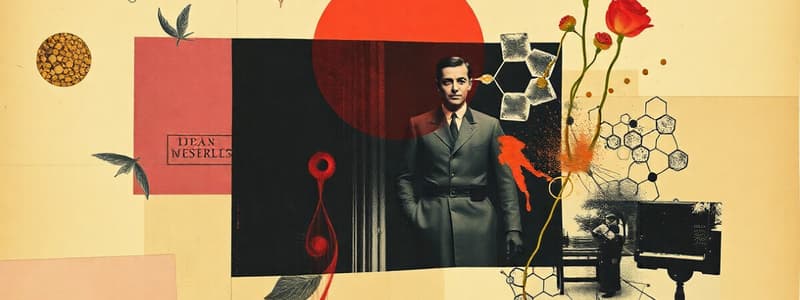Podcast
Questions and Answers
What are the five basic taste sensations?
What are the five basic taste sensations?
- Spicy, sweet, salty, sour, bitter
- Sweet, sour, bitter, umami, astringent
- Savory, sweet, sour, bitter, salty
- Sweet, salty, sour, bitter, umami (correct)
Which structure in the eye is primarily responsible for focus and clarity of vision?
Which structure in the eye is primarily responsible for focus and clarity of vision?
- Lens (correct)
- Iris
- Retina
- Cornea
How do semicircular canal receptors function within the vestibular apparatus?
How do semicircular canal receptors function within the vestibular apparatus?
- They detect sound waves.
- They monitor dynamic equilibrium. (correct)
- They monitor static equilibrium.
- They provide nutrients for the inner ear.
Which taste sensation is primarily associated with amino acids and proteins?
Which taste sensation is primarily associated with amino acids and proteins?
What is the primary role of taste buds?
What is the primary role of taste buds?
Which structure adjusts the amount of light entering the eye?
Which structure adjusts the amount of light entering the eye?
What mechanism does the vestibular system use to maintain equilibrium?
What mechanism does the vestibular system use to maintain equilibrium?
Which of the following is NOT a function of the retina?
Which of the following is NOT a function of the retina?
Which part of the ear is primarily responsible for balancing the body?
Which part of the ear is primarily responsible for balancing the body?
Which taste sensation is often associated with toxic substances?
Which taste sensation is often associated with toxic substances?
What role do vestibular receptors play in maintaining balance?
What role do vestibular receptors play in maintaining balance?
What characterizes the semicircular canal receptors in relation to equilibrium?
What characterizes the semicircular canal receptors in relation to equilibrium?
Which part of the eye is involved in detecting light intensity?
Which part of the eye is involved in detecting light intensity?
Which of the following statements about taste sensations is accurate?
Which of the following statements about taste sensations is accurate?
How do higher order sensory pathways affect taste perception?
How do higher order sensory pathways affect taste perception?
What structural feature of the eyeball is directly associated with the focusing of light?
What structural feature of the eyeball is directly associated with the focusing of light?
In the context of taste and smell, what is the importance of the gustatory pathway?
In the context of taste and smell, what is the importance of the gustatory pathway?
Which factor is least likely to influence taste perception?
Which factor is least likely to influence taste perception?
Which of the following statements accurately describes the structure of the retina?
Which of the following statements accurately describes the structure of the retina?
What distinguishes the five basic taste sensations from each other?
What distinguishes the five basic taste sensations from each other?
Flashcards are hidden until you start studying
Study Notes
The Chemical Senses - Taste and Smell
- Taste and smell are chemical senses
Taste Buds
- Specialized epithelial cells that respond to chemicals dissolved in saliva
- Found in papillae (tiny bumps on the tongue)
- Contain gustatory receptor cells
- Each taste bud contains 50-100 gustatory receptor cells; each cell responds to a specific taste
- These respond to chemicals dissolved in saliva
Taste Sensations and the Gustatory Pathway
- Sweet
- Sour
- Salty
- Bitter
- Umami (savory)
Influences of Other Sensations in Taste
- Temperature
- Texture
- Smell
- Sight
The Eye and Vision
- The eye is the organ of sight
- Light energy is converted into nerve impulses through the retina that reach the visual cortex, which is in the occipital lobe of the brain
- The eye is protected by accessory structures
Structure of the Eyeball
- Fibrous Tunic
- Outermost layer
- Provides shape and protection
- Composed of the sclera (white of the eye) and cornea (transparent layer)
- Vascular Tunic
- Middle layer
- Contains blood vessels, melanocytes, and choroid (prevents light from scattering within the eye)
- Ciliary body, which helps to maintain the shape of the eye and focuses the lens
- Iris, the colored part of the eye that controls the size of the pupil for regulating the amount of light that enters the eye
- Pupil (opening in center of the iris)
- Retina
- Innermost layer
- Contains photoreceptor cells (rods and cones)
- Rods are responsible for vision in dim light
- Cones are responsible for color vision
- Macula Lutea
- Area of the retina that is responsible for sharp central vision, due to a higher concentration of cones
- Fovea Centralis, a depression in the center of the macula lutea, contains only cones.
- Optic Disc
- Region where the optic nerve exits the eyeball
- Also known as the "blind spot" because it lacks photoreceptor cells
Regional Specialization of the Retina
- Fovea Centralis
- Has only cones.
- Provides the sharpest vision.
- Macula Lutea
- Area surrounding the fovea centralis.
- Provides good vision along with the fovea.
- Peripheral Retina
- Has more rods than cones
- Responsible for peripheral vision
- Optic Disc
- This region contains blood vessels and the optic nerve.
- It lacks photoreceptor cells.
The Ear and Equilibrium
- Outer Ear
- The outer ear includes the auricle (pinna) and the external auditory canal
- The auricle collects sound waves that are then channeled into the external auditory canal
- Middle Ear
- Air-filled space between the eardrum and the inner ear
- Contains the auditory ossicles (malleus, incus, and stapes) that transmit sound waves to the oval window
- Tympanic membrane (eardrum) vibrates in response to sound waves
- Inner Ear
- Fluid-filled space containing the cochlea (responsible for hearing) and the vestibular apparatus (responsible for balance)
- Cochlea
- Contains the organ of Corti, which is responsible for converting sound vibrations into nerve impulses
- Vestibular apparatus
- Contains the semicircular canals and vestibule
- These are equilibrium receptors that maintain our orientation and balance in space
- Vestibular receptors monitor static equilibrium (head position relative to gravity)
- Semicircular canal receptors monitor dynamic equilibrium (head movement)
Auditory and Equilibrium Pathways
- Sound waves travel through the external auditory canal to the tympanic membrane, causing it to vibrate.
- These vibrations are then transmitted to the ossicles in the middle ear.
- The stapes vibrates the oval window, which sets the fluid in the cochlea into motion.
- The movement of the fluid in the cochlea stimulates hair cells within the organ of Corti.
- Hair cells are specialized sensory receptors that convert sound vibrations into nerve impulses.
- These impulses travel to the auditory cortex of the brain.
- The vestibular apparatus uses the movement of fluid in the semicircular canals and vestibule to detect head movement and orientation.
- Vestibular receptors send signals to the brain that help us to maintain our balance.
Taste Buds
- Taste buds are sensory organs that detect taste
- Located in papillae (bumps) on the tongue
- Each bud has 50–100 epithelial cells
- Taste receptor cells are modified epithelial cells
- Basal cells are stem cells that differentiate into receptor cells
Taste Sensations and the Gustatory Pathway
- Sweet - sugars, saccharine, some amino acids
- Sour - acids
- Salty - metal ions (Na+)
- Bitter - alkaloids
- Umami - amino acids (e.g., glutamate)
Influences of Other Sensations in Taste
- Smell - Strongly influences taste - about 80% of what we taste
- Temperature - Influences taste - hot foods taste more intense
- Texture - Influences taste - smoothness versus roughness
The Eye and Vision
- The eye is the sensory organ that detects light
- Photoreceptors are specialized cells in the retina that detect light
- Light must pass through structures in the eye to reach the photoreceptors
Structure of the Eyeball
- Fibrous Tunic - outermost layer
- Sclera - White of the eye
- Cornea - Transparent part that allows light to enter
- Vascular Tunic - middle layer
- Choroid - Highly vascularized that nourish retina; absorbs light
- Ciliary Body - smooth muscle that controls lens shape; secretes fluid
- Iris - colored part of the eye that controls pupil diameter
- Retina - innermost layer
- Contains photoreceptors
- Pigmented epithelium - absorbs light, prevents reflection
- Neural layer (photoreceptor layer) - photoreceptors, bipolar cells, ganglion cells, etc.
- Photoreceptors - rods and cones - detect light
- Bipolar cells - conduct impulses from photoreceptors to ganglion cells
- Ganglion cells - axons form the optic nerve
Regional Specialization of the Retina
- Macula Lutea - center of retina where vision is sharpest
- Fovea Centralis - depression in the macula lutea that only contains cones - sharpest area of vision
- Optic Disc (blind spot) - region where optic nerve exits the eye - no photoreceptors - blind spot
The Ear and Equilibrium
- Ear is the sensory organ for hearing
- External Ear
- Auricle (pinna) - funnel-shaped structure that captures sound waves
- External auditory canal - carries sound waves to the tympanic membrane
- Middle Ear
- Tympanic membrane (eardrum) - membrane that vibrates in response to sound waves
- Auditory ossicles - malleus, incus, stapes - transmit vibrations from tympanic membrane to the oval window
- Inner Ear
- Labyrinth - includes membranous labyrinth
- Cochlea - snail-shell-shaped structure that contains hair cells that detect sound
- Vestibule - contains utricle and saccule that detect static equilibrium
- Semicircular canals - detect dynamic equilibrium
- Labyrinth - includes membranous labyrinth
Vestibular apparatus
- Equilibrium receptors are in semicircular canals and vestibule
- Vestibular receptors monitor static equilibrium (head position)
- Semicircular canal receptors monitor dynamic equilibrium (head movements)
Auditory and Equilibrium Pathways
- Sensory information from the inner ear travels via cranial nerve VIII (vestibulocochlear nerve) to the brain
- Auditory pathway travels to the temporal lobe
- Equilibrium pathway travels to the cerebellum
Studying That Suits You
Use AI to generate personalized quizzes and flashcards to suit your learning preferences.




